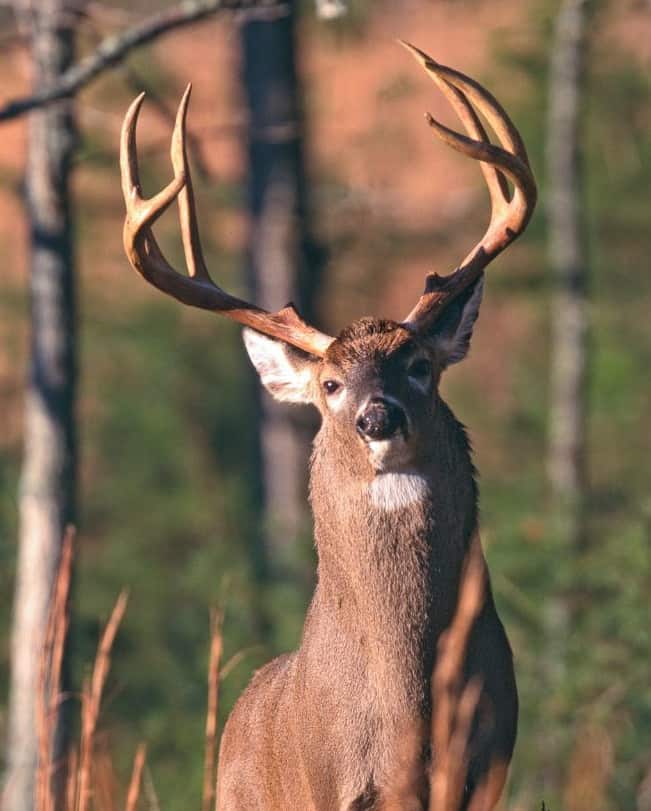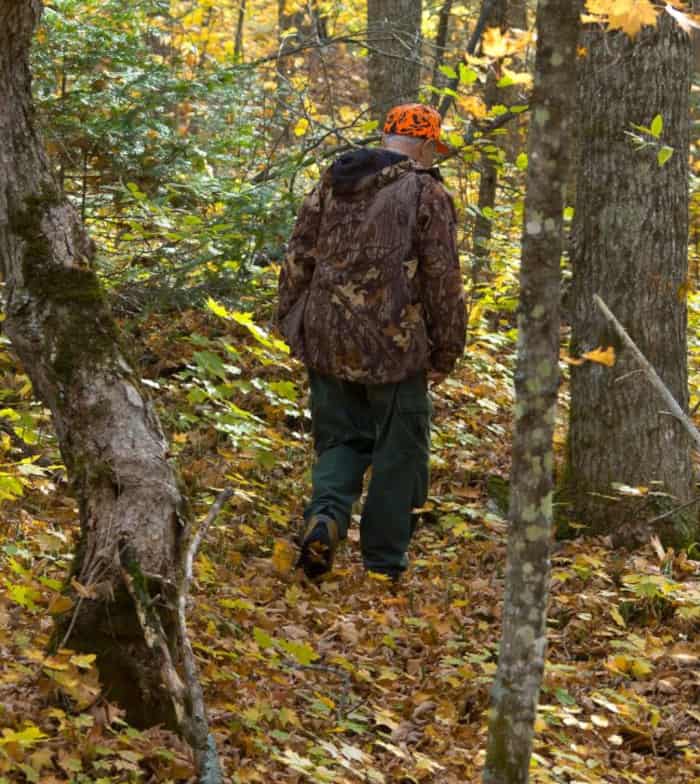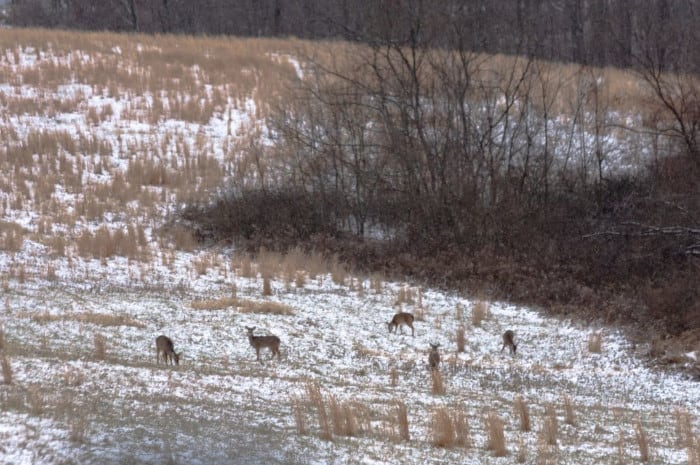Ask ten different deer hunters what they pack to deer hunt, and you’ll likely get ten different answers. Although there will probably be some overlapping answers between the group, you’ll also get some unique answers as well.
At my full-time job in the retail outdoors market, the rest of our staff and I are frequently asked questions about the ideal deer hunting gear list, what to pack for a deer hunt, or what the deer hunting gear must haves? Since those are very open-ended questions, several factors could influence my answer about the best gear to include in a deer hunting pack.

However, before I get into specific details about a whitetail deer hunting gear list, I wanted to go over a few things related to deer hunting packs.
What is a Hunting Pack or Hunting Kit?
In the simplest terms, a hunting pack is a container of some type used to hold or carry gear on your person while hunting.
For me, a hunting kit serves two purposes:
- Carry gear necessary for hunting (spare ammo, additional clothing for layering, etc.)
- Carry gear that may be needed for short-term survival.
Every year, hundreds of hunters across the United States become injured, missing, or lost while hunting. I’ve tried researching specific numbers to help with context and perspective, but most of the available statistical data is old or outdated.
To be prepared (or at least semi-prepared), I prep my kits with sufficient gear to survive at least 48 hours in the woods if I become lost or injured. Of course, the 48-hour prep is just my own personal number, so feel free to adjust accordingly.
Now, if you only hunt twice a year and rarely go more than 200 yards from your truck, then you probably won’t need to follow the same level of preparation that I’ve outlined below.
Down below, I’ll share an incident I encountered that made me rethink my approach to being prepared.
Deer Hunting Daypack versus Overnight Pack
When you start researching deer hunting packs or specific deer hunting gear, you will likely come across references to a day pack and a night pack. Let me review each pack type, so we are on the same page for the rest of this post.
Day Pack for Deer Hunting
Day packs (or daypack, depending on where you live) also go by several names, including:
- Deer Hunting Backpacks
- Hunting Bags
- Hunting Kits
The “day” term means that the pack is designed to carry items you might need on a hunting trip that only lasts one day. For example, you leave to go hunting in the early morning and then return at or after dark. A day pack is made to carry the necessary gear you may need or want for a single day’s trip.
Deer Hunting Pack
Most packs not marked or labeled as “day packs” are pack models or styles built to carry enough gear to last the hunter on an overnight trip or a trip that involves several nights. This style of pack is also commonly called:
- Night Pack
- Overnight Pack
These packs are generally larger than a day pack and carry more gear.
Types of Hunting Packs
Day and overnight packs are also available in several different configurations, including:
- Backpacks
- Fanny Packs
- Waist Packs
- Hunting Bags
These styles of packs are somewhat self-explanatory, so I’m not going to dive into great depth on each as most people understand what a fanny pack or backpack is.
Hunting Packs for Specific Types of Hunting
In addition to understanding the day or night pack differences, it’s also important to understand that some hunters have more than one hunting pack, and some use packs that are loaded explicitly with gear for a specific type of hunting or game species.
The two most common are gun packs and archery or bowhunting packs. Given the different types of hunting equipment, it makes sense that some hunters (including me) might utilize a hunting pack geared towards a specific hunting style.
In my case, I have four hunting packs:
- Deer Hunting Day Pack for Rifle
- Bowhunting Day Deer Pack
- Waterfowl Hunting Pack
- Overnight Hunting Pack
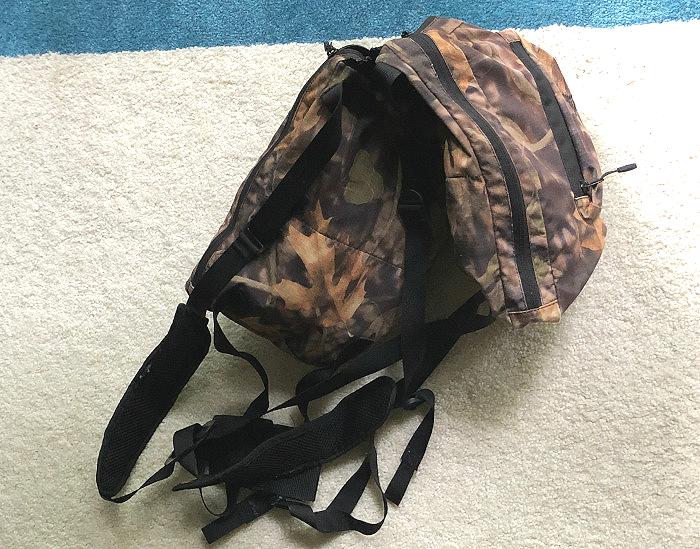
Gear List for Deer Hunting
To be clear, rather than list and discuss every item in each of my different hunting packs, I wanted to focus on specific gear that I consider essential for a hunting pack. So, for the purposes of this post, I’m going to skip topics like spare ammo, cartridge carriers, binoculars, hunting license, basic hunting clothing, etc. and focus on basic essential gear that I carry in every hunting pack for emergencies.
In addition, I’d like to point out that this list is based on my own opinions and geared towards the type of hunting that I do in specific geographies. This list is not etched in stone, so feel free to remove any item or items that are not applicable to you and replace them with an item or device that you think is indispensable to your hunting.
Something else to mention I try to walk a line between necessary items and weight. I prefer to travel light but be prepared (I’m an old Boy Scout back from the days when being a Boy Scout actually meant something). To maintain my “light but prepared” mindset, I consciously try to only carry the important pieces of gear that I feel are absolutely necessary. Again, my idea of “absolutely necessary” may not be the same as yours, but that’s OK.
Let’s get started:
Multitool
I find any good multitool to be an absolutely indispensable piece of gear for a hunting pack because of its versatility. I’m still amazed at the number of uses I’ve found for a multitool in the woods. Not only has it been a “lifesaver” in some cases, but they are the handiest tool to have. I could try to create a list of all the things I’ve been able to do with a multitool, but I think you get the idea without that list.
I have a multitool in every pack and wear one on my belt when I hunt. However, because my hands are on the larger size, I prefer a full-size multitool over a smaller or micro-sized one.
What’s the best multitool for hunting? Honestly, I think any well-made brand of multitool will fit this need, but I prefer the Leatherman brand of multitools. Of course, a Leatherman will cost more than most other brands, but you get what you pay for. That being said, brands like Outdoor Edge, SOG, and Gerber also make good quality multiuse tools as well.
While most multitools also come with an edged blade, I do prefer to have a good quality knife as well.
A Quality Hunting Knife
When I say “hunting knife,” I’m talking about a fixed blade instrument with a sturdy 3” to 4” blade. Like multitools, hunting knives are quite versatile and can be used in many different ways. The most common uses for a fixed blade cutting instrument are field dressing and cutting rope.
One could argue that a smaller folding knife is a better and more compact option, but I prefer the heft and durability of a fixed blade model. A folding unit can work, but they consist of more moving parts and are more prone to malfunction or break.
To be clear, bigger is not always better for hunting knives. In my humble opinion, you don’t need a 10-inch “Rambo” knife in a hunting pack. Instead, you need a dependable cutting tool that you can count on if problems arise.
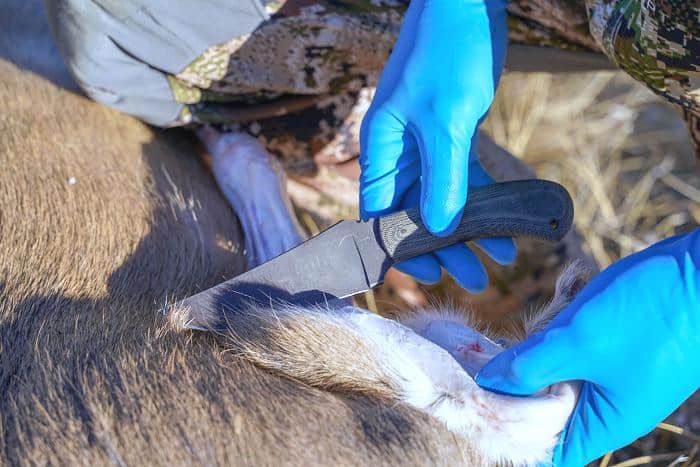
The last thing I’ll mention about hunting knives is the quality. I suggest buying a quality knife made by a known brand versus a cheap model from China. If you get lost or injured while hunting, you may be glad you spent a few extra dollars on a good knife.
Compass
While most hunters today would rather depend on a mobile phone, I carry a small compass in every pack I use. Even without a map to reference, I can use a compass to determine a direction of travel. I understand that you can use the rising and setting sun to determine east and west, but I prefer an actual compass that I can reference as I travel.
Now, if you only hunt 100 yards from your truck, you may not want a compass or consider it necessary, but I don’t like to rely on a phone for emergency communication or determining the direction of travel. And I’m not one of these anti-phone “boomers” because I like the capability of a smartphone.
A small compass isn’t expensive and is another item that most people don’t appreciate until you need it.
First Aid Kit
When I say first aid kit, I’m not talking about a large, fully stocked first aid kit. Instead, I’m referring to a minimal first aid kit containing just the basics. You can buy these mini first aid kits at places like Bass Pro or make your own.
Having had to use one more than once in my life on a hunting trip, the potential value is well worth the weight. My favorite style of kits is the ones that include small amounts of antiseptics.
I cut myself once pretty badly on a trip, and I’m convinced that the first aid kit kept the wound from getting infected, so I was able to finish the journey. Of course, I had to get stitches later, but the kit did its job.
Folding Saw
Some hunters might argue or balk at this suggestion, especially if their multitool already features a saw blade. I understand why someone might feel that way, but a small folding saw offers a much larger cutting surface and grip surface than a multitool saw blade.
I usually carry one about 8 inches long folded up and about 16” inches when the saw blade is deployed. A saw that size is excellent for clearing shooting lanes, removing limbs for a tree stand, or cutting through the pelvis of a game animal.
Plus, it’s an ideal tool for cutting up firewood in emergencies or as a tool to help build an emergency shelter.
While some hunters might balk at the weight of a folding saw, I purchase models that are lightweight and will float if dropped into water.
Flashlights
To me, there’s nothing worse than getting caught in the woods after dark without a light source. That’s why I always carry two spare flashlights in my hunting packs and extra batteries for each light. Having a light source may be the difference between making it back to your truck or having to spend the night in the woods.
I carry one handheld flashlight and one headlamp-style light. I like to use a headlamp light as my primary light source because of its hands-free use and keep the handheld unit as an emergency backup.
Rather than buy cheap batteries to keep on hand for each light, I prefer to spend money and purchase better quality batteries with a longer shelf life. This way, I don’t have to replace the emergency batteries in my pack every year.
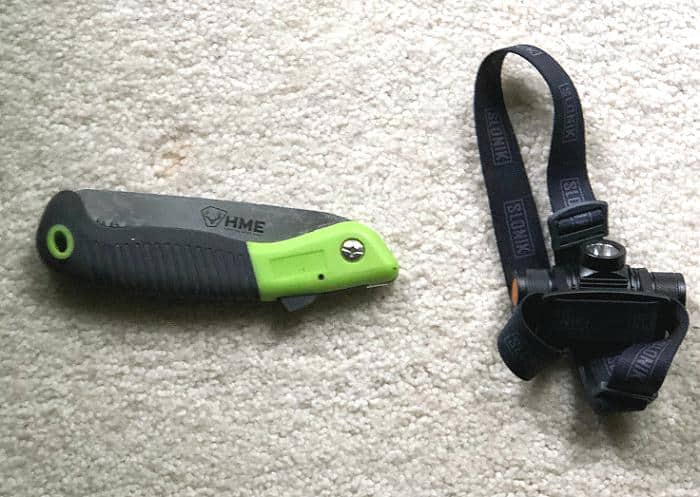
Firestarter Supplies
In my humble opinion, no hunting pack is complete without an emergency firestarter kit, so you can get a fire going as easily and quickly as possible. Most hunting seasons occur in the fall and winter, where temperatures can drop rapidly. In an emergency, the ability to start a fire for warmth may be lifesaving.
I carry a lighter and waterproof matches as sources for an emergency fire. The lighter is my primary ignition source, and the waterproof matches are my secondary ignition source if the lighter fails.
In addition to the ignition sources, I also carry a 35mm film canister containing either commercial fire starter material or cotton balls soaked in lighter fluid. These items are carried for fire-starting under wet conditions where locating dry tinder fuel is difficult. It can be challenging to get a fire going when everything is soaking wet, so the packed tinder can be invaluable.
Paracord and Rope
Also included in my pack is a short length of paracord and rope. I usually carry about 15 feet of both because both are extremely handy for many uses. I keep both wrapped in a small plastic bag to keep them dry.
Paracord is incredibly handy, and your imagination only limits its uses. The heavier rope can be used for activities such as towing a harvested deer out of the woods, tying or fastening items together, or even emergency firestarter.
Emergency Blanket
One of those emergency blankets can be worth its weight in gold if needed. Also called “mylar blankets,” an emergency blanket contains a reflective material that will help retain your body heat. They are light, thin, and work surprisingly well. Plus, they are available in pre-packed bags that are extremely small and take up little space.
If you ever find yourself in a bad situation and can’t get a fire going, one of these may be the difference between an uncomfortable night in the woods and hypothermia.
Rain Gear
If you had to spend the night in the woods in an emergency, staying dry is paramount as precipitation or wet clothing will reduce your core temperature at an accelerated rate. Plus, you never can tell when a rain storm will pop-up and you may want to keep deer hunting in the rain.
I carry an ultra-lightweight rain poncho or jacket that is pre-packed in a small plastic bag. It weighs maybe 2 ounces and is large enough to protect my body and gear from the rain. In addition, it can be utilized as a small emergency tarp for shelter purposes.
Duct Tape & Pen
I also carry a small amount of duct tape wrapped around a mini-pen. The duct tape is highly versatile and can be used for many different purposes, including an emergency bandage or Firestarter. In addition, the pen is handy if you hunt in a state that requires you to sign your tag when you tag an animal.
Emergency Water & Food
Finally, I keep a 16-ounce bottle of water in my day pack and several packets of beef jerky. The water can be rationed for hydration as needed in an emergency, and the packages of beef jerky will provide a small food source if needed. In addition, since the jerky is commercially sealed in individual packets, it has a long shelf life and will be edible for a year or two.
Spare Pair of Heavy Socks
This choice is probably more of a personal thing versus a commonly recommended piece of gear and clothing. My feet are generally one of the first parts of my body to start getting cold while hunting (depending on my choice of hunting boots). As such, I carry a spare pair of heavy wool socks in my pack for emergencies. In addition to keeping your feet warm, the socks could be used for other purposes, like a fire starting material, makeshift gloves to keep my hands warm, etc.
Now, as you read through that list, it probably sounds like a lot of gear essentials to pack, but it really isn’t. I keep all the items listed above in a sealed one-gallon plastic bag in my pack. It weighs right around 3 pounds and stows away nicely in my pack. While I’m a bit of a stickler about carrying unnecessary weight or gear I don’t need, this is a weight I don’t mind having.
Is it Really Necessary to Pack that Much Gear in a Hunting Pack?
That’s a valid question and one that I see and hear asked quite often. However, I don’t know if a black and white answer exists due to factors like:
- The type of hunting being done
- The remoteness of the hunting area
- Cell Phone coverage
- Your Preferences for being prepared
Let me try to address each factor individually:
The Type or Style of Hunting Being Done
If you typically hunt a few hundred yards from where you park, then you probably don’t need to pack all the gear listed above. This is especially true if you have cell phone coverage when you hunt since a cell phone can mitigate almost all emergencies.
However, if you hunt in scenarios or locations where you’re miles away from where you parked without any cellular coverage, then it might be worth evaluating the contents of your current hunting pack.
The Remoteness of the Hunting Area
Under most circumstances, the more remote the area, the fewer the number of people around to offer assistance. If you’re hunting in a remote location, I’d suggest reviewing the list above and seeing if any of those items meet your needs. The last thing you want to do is end up in a situation without any supplies or gear that can help.
In addition, most remote areas also feature little to no cellular service, which will limit your opportunity to call for help or use the phone to summon help.
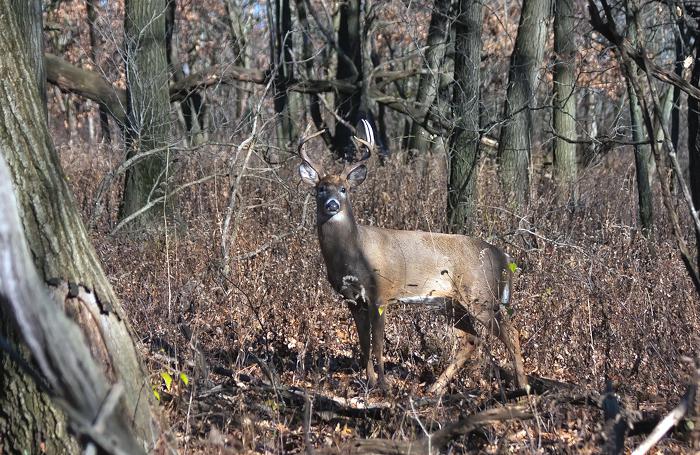
Cell Phone Coverage
I’ve mentioned it previously, but cell phone coverage can play a huge role in evaluating the gear that you may want to carry. In situations where a hunter has good cellular service, they can probably pack a little lighter, knowing that help can be summoned in the event of an emergency. However, remember that the help may take some time to get to you, so I suggest preparing accordingly.
If you hunt in an area with little to no cell service, then I’d definitely suggest considering some or all of the pack items I listed above. Without cell service or any other communication device, you may be on your own for a bit.
Another point I’d like to mention with cell service and cell phones: They are products with electrical components that break, malfunction, run out of battery life, or fail. So while I count on a cell phone in situations where I have coverage, I prefer to be sufficiently prepared if the phone fails.
Your Comfort Level of Preparedness
Every hunter has their own beliefs or thoughts on the various levels of preparedness when venturing out in the woods. Some believe an emergency situation will “never happen to them,” while others probably go a little overboard and pack enough gear to live a week in the woods. I tend to fall somewhere between those two trains of thought.
I try to take a realistic approach to being prepared so that I’m at least a little bit prepared versus being utterly unprepared in the event of a situation.
In an attempt to answer the question about needing that much gear, I’d suggest the following:
First, the amount of gear that you pack is an individual decision that can really only be answered by you.
Second, I’d try to realistically evaluate the style of hunting that you usually do, along with typical cell phone coverage when you hunt and your comfort level of being prepared.
Then I’d say plan and pack your hunting pack accordingly based on your answers to those questions.
The Situation That Changed my Hunting Pack Essentials
Previously, I had mentioned that I encountered a situation that changed my thoughts on what went into my deer pack, and here’s that story:
Several years ago, I went with a group of friends whitetail hunting from a deer camp in a northern portion of Michigan called the Upper Peninsula. I had been to Michigan before but never hunted; this was my first experience in the Upper Peninsula.
I researched the weather and knew it would be cold, so I planned and packed accordingly. We hunted out of an old-fashioned cabin with bunk beds and no electricity. The buddy hosting the hunt would take groups of us out each morning and evening in a truck and drop each hunter off at a designated spot with an existing tree stand. Then the group could come back and pick the hunters up at a pre-set time.
I should add that there was no cell service where we were, and it was a remote location. The first two days, I had seen some does but nothing with antlers. On the 3rd evening hunt, I decided to switch locations hoping to see something. I was dropped off at a different stand and climbed in to hunt.
Just before dark, a small 6-point walked up, and I decided to go ahead and take a shot as the entire group had only seen a few bucks so far, and we were leaving in two days. So I took a shoulder shot at about 75 yards with my .243. It looked like a solid hit, but he ran off without going down within sight. So I waited about 30 minutes and decided to try to find him.
I found quite a bit of blood with a good trail, but as I moved along, the blood trail started to lighten up and become more difficult to locate. I was so focused on trying to find this downed deer that I wasn’t paying all that much attention to the direction I was traveling.
At some point, the blood trail disappeared completely, so I took out my flashlight as darkness was falling. I started making a circle search pattern from the last blood trail. I found another blood trail that went off in a different direction from his original last known path, so I started following it. The blood trail started to pick up again, and I finally found my buck. It turns out I had either made a not-so-great shot, or the bullet had struck something that had changed its path.
I tagged him (per MI rules) and noticed that my flashlight was starting to die. I keep spare batteries for just such an occasion, but they were also dead as well. I had my cell phone on my (even though I had no service, I was playing games on the phone to help pass the time in the stand).
Believing that I wasn’t that far from my tree stand, I decided to stay with my deer and expected to see or hear the truck as it was coming to pick me up. After about an hour and a half after dark, I hadn’t seen or heard any vehicle or people, so I decided to backtrack back to my stand using the blood trail. Only having the light from a cell phone, it didn’t take long to realize that I was having real trouble seeing the blood trail now, and the temperature was really dropping.
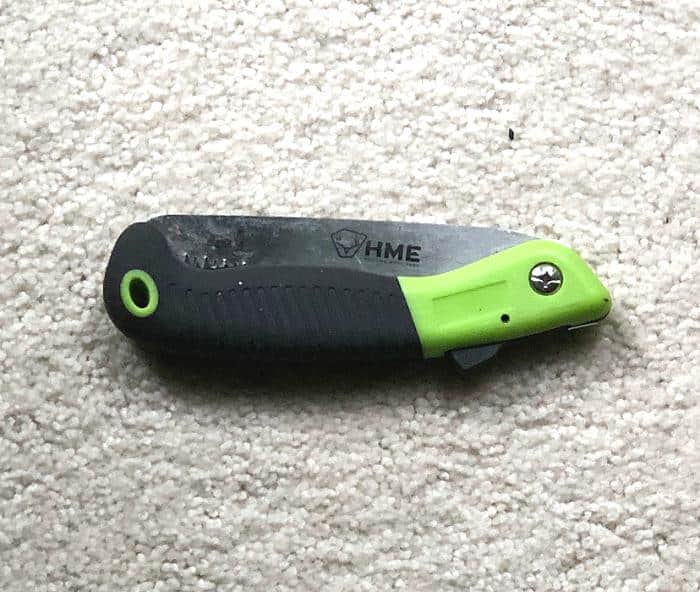
Plus, with such a small light source, everything looked different at night, so I had trouble getting my bearings as to which direction the stand was. To make matters worse, the light from my cell phone was starting to die, so I would end up without a light source pretty soon.
Given the circumstances, I decided to return to the down deer and wait things out there. I knew that the group would come out looking for me when they couldn’t locate me at my last known deer stand. As I took an inventory of the things I had on my person, I realized that I had no way to start a fire, a dying light source, a little bottled water left, and a half-eaten protein bar.
I wasn’t panicking because I knew they would be out looking for me, but I was starting to get a little concerned because it was getting quite cold. Even though I had dressed appropriately with insulated base layers, I was beginning to feel the cold in my feet and hands. I sat down at the deer, leaned my back up against a tree, and dug down in my coat to stay warm.
About an hour later, I heard three back-to-back gunshots in the distance and responded with three rapid shots from my rifle. About 15 minutes later, I heard someone call my name and a flashlight moving off in the distance. I had been located, and the group came in to help me drag my deer out. I took some good-natured ribbing about the incident (and still do from time to time with those friends).
In hindsight, it would have been a much better decision to wait at the tree stand until the others arrived, and then they could have helped me track the deer as a group.
While nothing serious happened to me, it really opened my eyes to how completely unprepared I was if I became lost or injured. I always considered myself a better-than-average outdoorsman but felt I had failed miserably in terms of being a prepared hunter. So based on that incident, I made it a point to be better prepared in the future.
FAQS
Here are some commonly asked questions that I see, hear, or read online focusing on hunting essentials, hunting checklist, and must have hunting gear:
Should I pack a GPS unit when I hunt?
The answer probably depends on the terrain that you hunt and the distances that you typically travel when hunting. For example, if you live in Wyoming and hunt Mule Deer, then it might make sense to have a GPS unit in your pack to help with navigation.
There have been times when I’ve been on hunts where one of the hunting party (usually the guide) carried a GPS unit, so I’ve seen them used. They are certainly a convenient way to navigate.
I prefer a compass because it’s a simpler tool that doesn’t require batteries and doesn’t require a satellite connection to establish position. However, a compass isn’t as helpful as a GPS unit because a compass just provides general directional information.
What’s a deer hunting kit?
A deer hunting kit is another name used to describe all the gear used for deer hunting, along with the pack or bag that the gear is stored in. For example, a typical deer hunting kit may contain items like:
- Scent control products
- Spare ammunition
- Skinning knife or field dressing kit
- Bug spray or cream (unscented)
- Tree stand lanyard (for pulling the unloaded firearm up into a tree stand)
- Safety harness and safety line
When deer hunting, hunters should take along an extra of which item?
Although opinions will vary greatly on this topic, my answer would be an additional light source. To me, there’s nothing worse than getting caught in the woods after dark without a light. Having a second light source or backup light source is an easy way to ensure that doesn’t happen.
What’s the difference between a day hunt pack and a night hunt pack or overnight hunt pack?
A day pack or day hunting pack is designed to carry the necessary hunting items for a single day’s worth of hunting. When a hunter heads out to hunt in the morning and then returns the same day, that’s considered a day hunt.
A night hunt pack or overnight hunting pack is a hunting pack designed to carry the necessary hunting items and supplies to camp overnight or camp for several nights while hunting.
Because hunters typically need more gear for overnight hunts, the overnight hunting packs are generally larger sized compared to typical day packs.
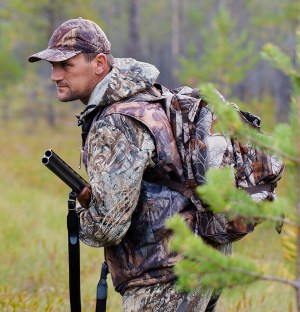
Born and raised in the North Carolina foothills, Andy was introduced to the outdoors at a very young age. Like most beginning hunters, he started out hunting small game like rabbits and squirrels, then graduated to larger species like Whitetail Deer. Although he’s an avid deer and turkey hunter, he still enjoys hunting small game as well. Andy has worked in the hunting and fishing industry for nearly 25 years.



